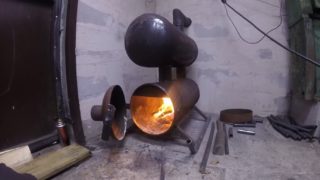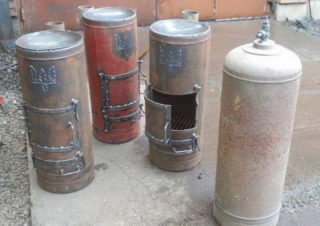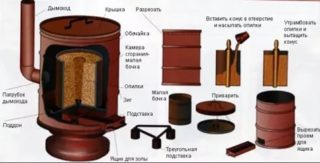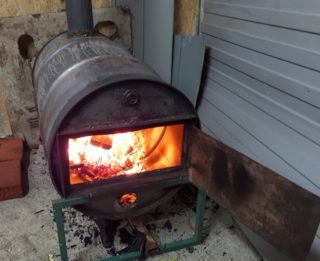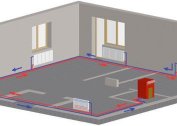A homemade gas cylinder stove was first made from improvised materials in 1918, when, due to a humanitarian disaster in Petrograd, central heating ceased to function. In most buildings of the 20th century, stoves and fireplaces carried exclusively decorative and aesthetic functions, they could not heat the premises. The current situation was aggravated by a shortage of firewood, so local workshops launched large-scale production of compact and economical "bourgeois", which are in great demand even after more than 100 years.
Varieties of gas cylinder stoves
For decades, cylinder stove manufacturers have improved their specifications. Today they are completely safe in their use, still economical and already able to heat rooms with a considerable area. Such furnaces can be made independently, it is enough to prepare the source material - an already exhausted gas cylinder.
Two types of potbelly stoves are made - horizontal and vertical. Each has its own design features. They do not differ in efficiency, they have only excellent external characteristics.
Horizontal furnaces
When constructing a horizontal furnace, an opening for the furnace is made from the end side of the cylinder, then the door is mounted. Inside the horizontal potbelly stove, as a rule, grate-irons are not installed in order to more rationally use the internal space. Instead, holes are drilled in the lower part in approximately 5-6 rows, and a flat duct is welded from the outside, where ash will accumulate. Such a box is recommended to be made of sheet metal. If you weld a metal sheet on top, a functional hob may come out.
The case of a horizontal furnace is attached to a frame that has previously been welded from a corner or steel pipes. It is recommended to use this design for heating a country house, a garage, and it can also be mounted in a bathhouse.
Vertical oven
First you need to prepare the spent gas cylinder and install it in a vertical position. At a convenient height for a person, an opening of the furnace is cut. The optimal size is 30 * 20 cm. Below you make a blowing hole with dimensions of approximately 20 * 10 cm.
Such an oven is additionally required to be equipped with grates. A lattice is made of reinforcing bars. It is not recommended to firmly fix it inside the stove, just put it on the corners welded to the walls. When the grate burns out, it will be quite simple to replace them.
The upper convex surface of the cylinder is cut off, a circle made of sheet metal is welded in its place. In the future, this will allow you to use this surface for cooking and tea. If there is a need for such a stove, a hole under the chimney is made from the side surface of the furnace, and a short horizontal knee is mounted. If there is no such need, a hole for the chimney is made at the installation site of the gearbox.
It is recommended to give preference to a vertical potbelly stove if the area of the room is small. To install such equipment does not require additional care about the construction of the supporting structure, so it can be moved.
DIY materials and tools
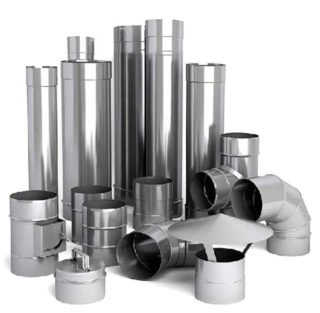
Before proceeding directly to the manufacture of the furnace from a gas cylinder, you need to make a drawing and prepare all the necessary materials. Required:
- several metal corners;
- a pipe that will perform the function of a chimney;
- fittings;
- metal (sheet thickness should be at least 3 mm).
Of equipment and tools will be involved:
- drill and drill of the right size;
- pliers, chisel, hammer;
- grinder;
- welding machine;
- marker.
Experienced masters when creating a potbelly stove recommend paying attention to the fact that the chimney should not go along the shortest path. Otherwise, heat will also go away with the combustion products. The most preferred type of chimney is a broken pipe.
As fuel, it is best to use firewood and coal, in a pinch, carpentry waste and household garbage are suitable for heating. It is important to understand that burning / melting of plastic and other synthetic materials releases toxic substances into the air, which can negatively affect one's well-being.
Features and principle of operation
A cylinder stove made it possible to realize the principle of long-term combustion, which is based on the physicochemical phenomenon of pyrolysis - fuel decay against a background of oxygen deficiency and the combustion of gases emitted. With proper operation, one bookmark of firewood is enough for 4-8 hours of continuous burning.
The peculiarity of such "heaters" is that the air supply pipe with a flap at the end is in a vertical position and goes out through the top of the stove with a small gap.
The pipe has vertical mobility. Its lower end is equipped with a massive disk with guides for the flow of gases. A chimney is welded to the top of the stove to its side surface. Firewood is loaded vertically into a potbelly stove, with the help of disks “fuel” is pressed to the grate. As the wood burns, the disc lowers and air is accessed to the upper layer of firewood, which is subjected to pyrolysis.
Advantages and disadvantages
The prevalence of bourgeois is due to the large number of its advantages:
- High efficiency. The generated heat does not fly into the pipe.
- Simplicity of manufacturing, installation and operation.
- Cheapness. It is possible to make such a “heater” from improvised materials.
Despite the large number of advantages, the equipment still has disadvantages:
- The inability to report firewood to the furnace until the previous bookmark is completely burned.
- The design is not effective if you want to quickly heat a cooled room.
- It is impossible to interrupt the combustion process.
- If draft decreases, the potbelly stove begins to smoke.
There is a wide variety of boilers and other equipment for heating, so it is not recommended to install stoves from cylinders in residential premises. They are optimally suited for greenhouses and non-residential premises, such as a garage.
